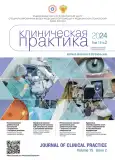Treatment of a patient with massive osteochondral exostosis of the radial neck: clinical case
- Authors: Vasilyev I.A.1,2, Maysigov M.N.1, Logvinov A.N.1, Frolov A.V.1,2, Bessonov D.A.1,2, Ilyin D.O.1,2, Korolev A.V.3,2
-
Affiliations:
- European Clinic of Sports Traumatology and Orthopaedics (ECSTO)
- Peoples' Friendship University of Russia
- European Clinic of Sports Traumatology and Orthopedics (ECSTO)
- Issue: Vol 15, No 2 (2024)
- Pages: 81-88
- Section: Case reports
- URL: https://journals.rcsi.science/clinpractice/article/view/262734
- DOI: https://doi.org/10.17816/clinpract626315
- ID: 262734
Cite item
Full Text
Abstract
BACKGROUND: Osteochondroma (osteochondral exostosis) is the most common benign neoplasm of bone tissue, accounting for up to 9% of all bone tumors. Possible manifestations of a single osteochondral exostosis are pain, a limited range of motion, compression of vascular or neural structures, and crepitus. The literature describes several clinical cases of the treatment of patients with osteochondral exostosis of the proximal radius. A distinguishing feature of the proximal radius’s anatomy is the close location of such anatomical structures as the posterior interosseous nerve, the enthesis of the distal biceps tendon, and the proximal radioulnar joint.
CLINICAL CASE DESCRIPTION: This clinical case for the first time describes osteochondroma of the radial neck, which causes supination deficiency.
CONCLUSION: The surgical treatment allowed us to achieve excellent treatment results with the complete restoration of the function and range of motion in the elbow joint. The key aspect is the knowledge of this segment’s anatomy.
Full Text
##article.viewOnOriginalSite##About the authors
Ivan A. Vasilyev
European Clinic of Sports Traumatology and Orthopaedics (ECSTO); Peoples' Friendship University of Russia
Author for correspondence.
Email: dr.vasilyev.ivan@gmail.com
ORCID iD: 0000-0002-1163-950X
Graduate Student
Russian Federation, Moscow; MoscowMusa N. Maysigov
European Clinic of Sports Traumatology and Orthopaedics (ECSTO)
Email: mmaysigov@emcmos.ru
ORCID iD: 0000-0002-2096-5876
SPIN-code: 2576-3874
MD, PhD
Russian Federation, MoscowAlexey N. Logvinov
European Clinic of Sports Traumatology and Orthopaedics (ECSTO)
Email: logvinov09@gmail.com
ORCID iD: 0000-0003-3235-5407
SPIN-code: 2505-9840
MD, PhD
Russian Federation, MoscowAlexander V. Frolov
European Clinic of Sports Traumatology and Orthopaedics (ECSTO); Peoples' Friendship University of Russia
Email: afrolov@emcmos.ru
ORCID iD: 0000-0002-2973-8303
SPIN-code: 9712-2491
MD, PhD
Russian Federation, Moscow; MoscowDmitry A. Bessonov
European Clinic of Sports Traumatology and Orthopaedics (ECSTO); Peoples' Friendship University of Russia
Email: dbessonov@emcmos.ru
ORCID iD: 0000-0002-0532-9847
Graduate Student
Russian Federation, Moscow; MoscowDmitry O. Ilyin
European Clinic of Sports Traumatology and Orthopaedics (ECSTO); Peoples' Friendship University of Russia
Email: ilyinshoulder@gmail.com
ORCID iD: 0000-0003-2493-4601
SPIN-code: 7947-5121
MD, PhD
Russian Federation, Moscow; MoscowAndrey V. Korolev
European Clinic of Sports Traumatology and Orthopedics (ECSTO); Peoples' Friendship University of Russia
Email: akorolev@emcmos.ru
ORCID iD: 0000-0002-8769-9963
SPIN-code: 6980-6109
MD, PhD, Professor
Russian Federation, Moscow; MoscowReferences
- Tepelenis K, Papathanakos G, Kitsouli A, et al. Osteochondromas: An updated review of epidemiology, pathogenesis, clinical presentation, radiological features and treatment options. In Vivo. 2021;35(2):681–691. doi: 10.21873/invivo.12308
- Garcia RA, Inwards CY, Unni KK. Benign bone tumors-recent developments. Semin Diagn Pathol. 2011;28(1):73–85. doi: 10.1053/j.semdp.2011.02.013
- Ng C, Bibiano L, Grech S, Magazinovic B. Antecubital antecubital fossa solitary osteochondroma with associated bicipitoradial bursitis. Case Rep Orthop. 2015;2015:560372. doi: 10.1155/2015/560372
- Hohenberger GM, Schwarz AM, Maier MJ, et al. Safe zone for the posterior interosseous nerve with regard to the lateral and posterior approaches to the proximal radius. Surg Radiol Anat. 2018;40(9):1025–1030. doi: 10.1007/s00276-018-2004-6
- Kocher T. Textbook of operative surgery. Operations at the elbow. 3rd ed. Stiled H.J., Paul C.B., translators. London: Adam and Charles Black; 1911. 723 р.
- Hackl M, Wegmann K, Lappen S, et al. The course of the posterior interosseous nerve in relation to the proximal radius: Is there a reliable landmark? Injury. 2015;46(4):687–92. doi: 10.1016/j.injury.2015.01.028
- Berdusco R, Louati H, Desloges W, et al. Lateral elbow exposures: The extensor digitorum communis split compared with the kocher approach. JBJS Essent Surg Tech. 2015;5(4):e30. doi: 10.2106/JBJS.ST.N.00048
- Herget GW, Kontny U, Saueressig U, et al. [Osteochondroma and multiple osteochondromas: recommendations on the diagnostics and follow-up with special consideration to the occurrence of secondary chondrosarcoma. (In German)]. Radiologe. 2013;53(12):1125–1136. doi: 10.1007/s00117-013-2571-9
- Bernard SA, Murphey MD, Flemming DJ, Kransdorf MJ. Improved differentiation of benign osteochondromas from secondary chondrosarcomas with standardized measurement of cartilage cap at CT and MR imaging. Radiology. 2010;255(3):857–865. doi: 10.1148/radiol.10082120
- Alsawadi A, Abbas M, Stanton J. Bicipital tuberosity osteochondroma causing painful clicking around the wrist: Case report and literature review. Hand Surg. 2012;17(2): 229–232. doi: 10.1142/S0218810412720227
- Cho CH, Jung GH, Song KS, et al. Osteochondroma of the bicipital tuberosity causing an avulsion of the distal biceps tendon. Orthopedics. 2010;33(11):849. doi: 10.3928/01477447-20100924-28
- Kim JP, Seo JB, Kim MH, et al. Osteochondroma associated with complete rupture of the distal biceps tendon: Case report. J Hand Surg Am. 2010;35(8):1340–1343. doi: 10.1016/j.jhsa.2010.05.018
- Oz O, Yücel M, Ulaş U, et al. Superficial radial neuropathy and brachioradial motor nerve palsy associated with proximal radius osteochondroma. Neurol Neurochir Pol. 2010;44(2):208–210. doi: 10.1016/s0028-3843(14)60013-x
Supplementary files













